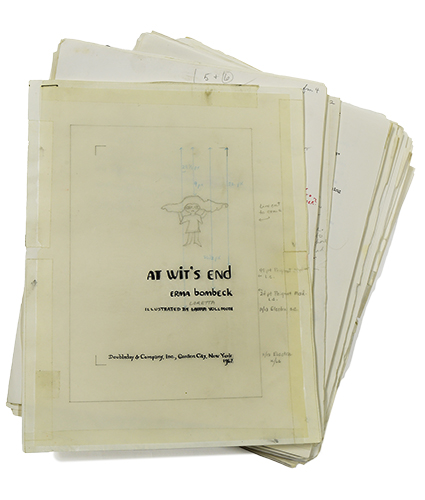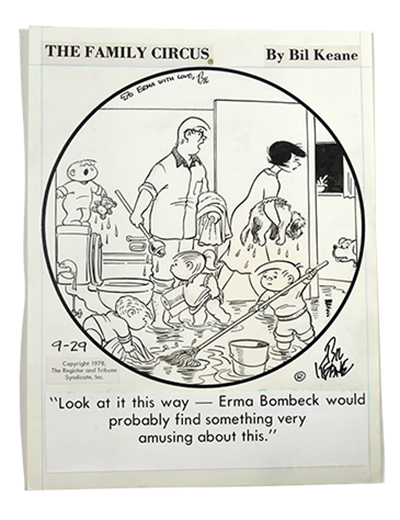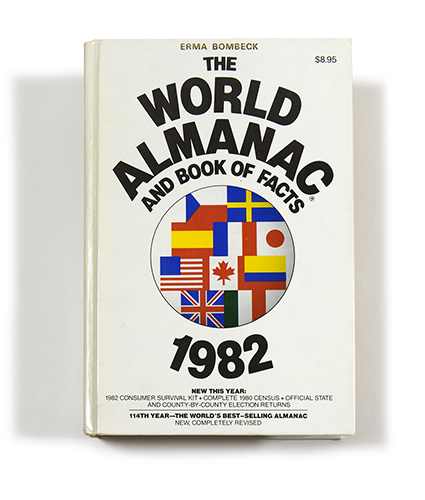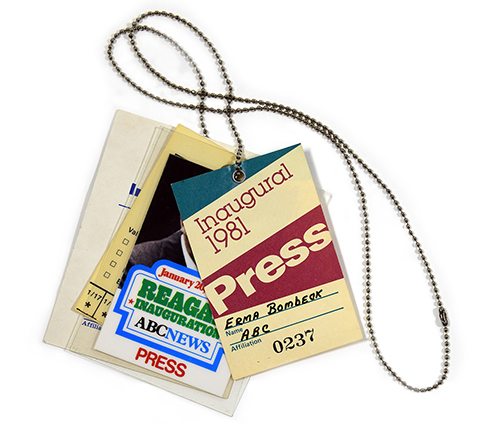Humor that transcends time
A gift from the family of one of America’s funniest women, the collection of Erma Bombeck finds its home at the University of Dayton Libraries.
A UPS truck rounded the corner on Frericks Way on a glorious morning last spring with 78 boxes filled to the brim with artifacts reflecting a life lived with hilarity and heart. Destination: the University of Dayton’s archives.
The original manuscripts, columns, handwritten notes, speeches, articles and memorabilia of the late Erma Fiste Bombeck ’49, one of the great American humorists of the 20th century, had ended its 1,800-mile cross-country journey to her alma mater.
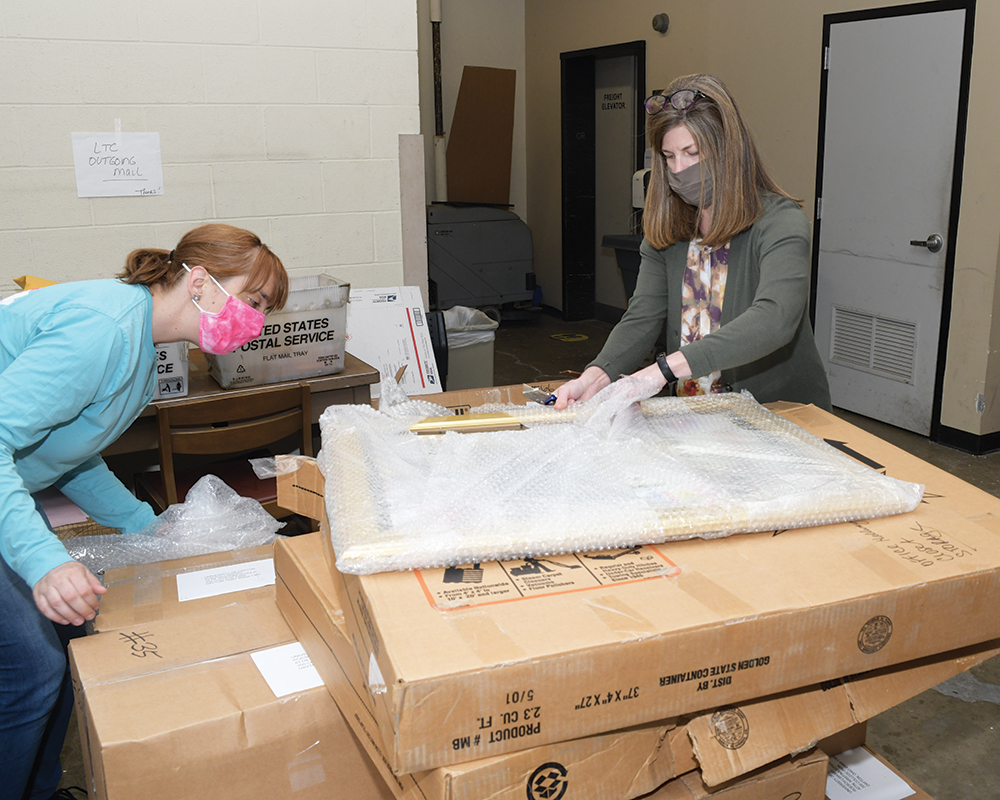
It’s a fitting final chapter: This is where Bombeck first heard “three magic words” from her English professor, Brother Tom Price, S.M. ’11: “You can write!” That encouragement catapulted a career that encompassed more than 4,500 syndicated columns about the foibles of family life and a dozen books, including nine on The New York Times’ Best Seller list. Forever, Erma, published after her 1996 death, also cracked the coveted list.
“It’s been a long journey, but she’s absolutely home,” said son Matt Bombeck about the long-awaited arrival of Bombeck’s papers, in the works for more than 20 years. “It’s bittersweet, but we know the collection is going to the right place. We know it will be well taken care of and how special it will be to the University and to us.”
“It’s been a long journey, but she’s absolutely home. It’s bittersweet, but we know the collection is going to the right place. We know it will be well taken care of and how special it will be to the University and to us.”
Not to mention scholars, writers, students and Erma aficionados.
“The collection is completely irreplaceable,” said Ed Hoffman, a rare book collector in Columbus, Ohio, who specializes in Americana, especially Ohioana and the works of humorist James Thurber. “Erma Bombeck’s archive and papers are a unique and comprehensive collection representing the storied career of this enormously popular humorist, columnist and author. [The collection] includes the original manuscripts of most of her books; a huge file of her columns over 30-plus years; and an extensive record of correspondence and documents shedding light on her connections to publishers, editors and other writers.
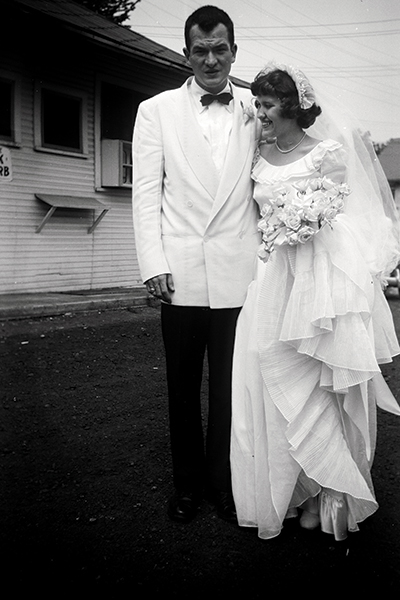
“The fact that Erma and her husband and then her family were able to retain and safeguard so much of the output from her ‘working life’ and see that it will live on at the University of Dayton is a wonderful labor of love,” said Hoffman after he and his rare-book collector wife, Tina, perused the collection last May before it was catalogued.
That assessment might surprise her children. Matt, a screenwriter in Los Angeles, said their mom “let go of things a lot easier” than their dad, Bill Bombeck ’50, whom she dated while both were students at UD and married upon graduation.
“My dad was the more sentimental of the two, 100 percent. He saved everything. I have the dog’s vaccination record from 1980,” said Matt Bombeck, displaying a streak of his mother’s humor.
“She wasn’t much of a saver, and this was pre-digital. I’m sure they’ll be no hidden troves in the Britney Spears archives in 2060,” he quipped. “My dad, on the other hand, does have his third grade report card from St. Anthony’s, in case anyone is interested.”
Still, the collection, now largely processed and available for viewing, is substantial.
Last April Matt and his wife, Jackie, spent a week in a Scottsdale, Arizona, warehouse sorting through a mountain of material in crumbling boxes that longtime assistant Norma Born had methodically inventoried for UD archivist Kristina Schulz and now-retired librarian Fred Jenkins. In a 2019 trip, the librarian and archivist marked their wish list for the Erma Bombeck collection, from original columns and Good Morning America and Maggie sitcom scripts to commencement addresses and correspondence. In box No. 6: the TV script for a proposed pilot, “The Ties That Bind ... and Gag.” In box No. 22: Bombeck’s scrawled notes about column ideas on scraps of paper, including an airline napkin. In box No. 71: copies of The World Almanac and Book of Facts that named her one of the 25 Most Influential Women in America. Six of the boxes include original columns written over more than three decades.
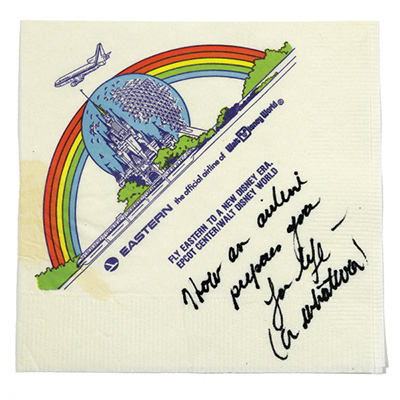
At the height of her popularity, Bombeck’s At Wit’s End column that chronicled the absurdities of everyday life reached more than 30 million readers and “won her the permanent place of honor in American life: the refrigerator door,” wrote syndicated columnist Ellen Goodman after the writer’s death from complications from kidney transplant surgery.
With the help of a $50,000 gift from the Bombeck family, Schulz is preserving and digitizing the columns, which are on newsprint and fragile. She hired Katie Jarrell, who earned a master’s degree in library and information science in spring 2021 from Kent State University, as project archivist to process the collection.
The two will oversee the creation of an electronic finding aid, develop an online repository for parts of the collection and launch a preview exhibit this spring in the Stuart and Mimi Rose Gallery on the first floor of Roesch Library. A major exhibit is planned for 2024.
Processing Bombeck’s papers has been an eye-opening journey of delightful discovery for Jarrell, who was born six weeks after Bombeck died.
“My mom grew up in the ’60s and ’70s, and she was a big fan of Erma Bombeck. She had her books and clipped her columns,” Jarrell said. “In all my reading of her work, I haven’t found an instance where she didn’t come across as genuine and authentic. She sounds like she could be my mom — she’s that relatable.”
“My mom grew up in the ’60s and ’70s, and she was a big fan of Erma Bombeck. She had her books and clipped her columns. In all my reading of her work, I haven’t found an instance where she didn’t come across as genuine and authentic. She sounds like she could be my mom — she’s that relatable.”
For a group of curious visitors, Schulz and Jarrell pulled out magazine cover stories; a 1977 New York Times’ Best Seller list plaque for The Grass is Always Greener Over the Septic Tank — her first book to garner that attention; a certificate from the National Academy of Recording Arts and Sciences for Bombeck’s Grammy-nominated comedy album, Motherhood: The Second Oldest Profession; a photo of an Arizona Kidney Foundation billboard with Bombeck’s oversized driver’s license and the plea, “Make this a license to live. Be an organ donor”; and files of galley proofs, columns and notes.
Holding up a large gold-framed photo of the family riding in a rose-covered white convertible when Bombeck served as grand marshal of the 1986 Rose Parade, Schulz said she planned to hang it on the wall in the archives’ reading room. Here, scholars and students will discover (or rediscover) the timeless wit and wisdom of a beloved humorist Life magazine dubbed the “Socrates of the Ironing Board.”
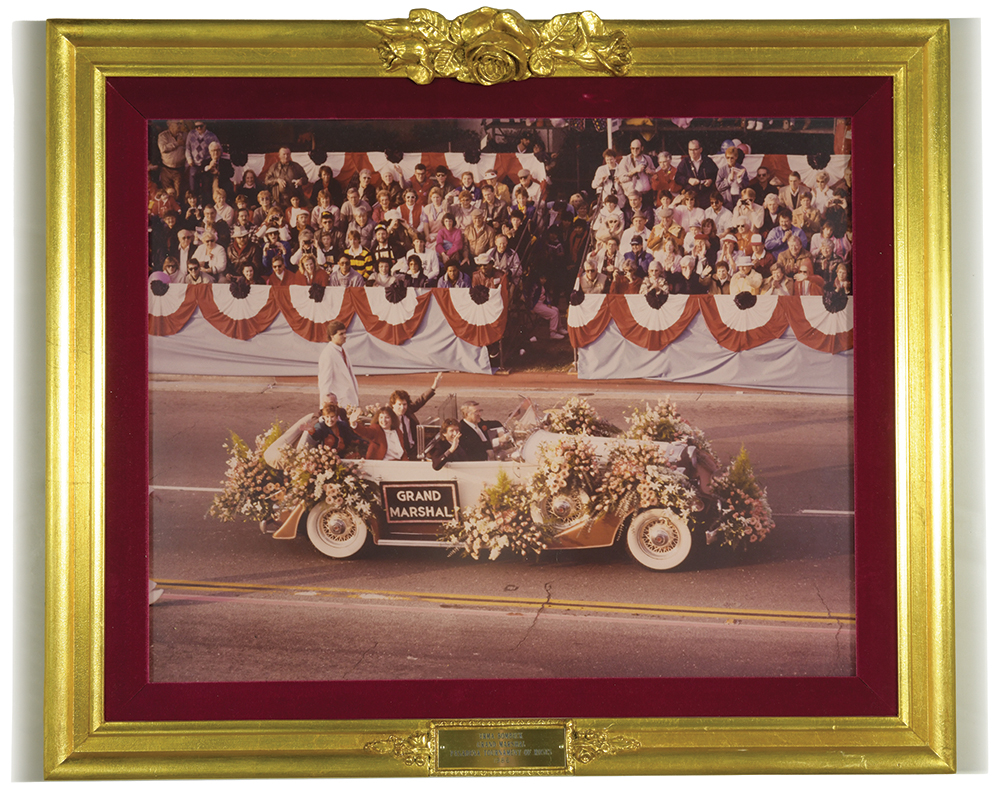
But they’ll discover so much more. Consider these finds:
- A funny handwritten note from Abigail Van Buren after a copy editor for the Marietta Times mistakenly placed Bombeck’s headshot over her Dear Abby column: “Dear Erma — Will you get your face out of my column? Or should I get my column out of your face? Love you — Abby.”
- A mixture of comical and touching letters to her son Andy when he taught school in American Samoa in 1980 and volunteered for the Peace Corps in Liberia in 1983: “I think the older both of us become, the more I appreciate your gentleness and your love. I am so proud that you have the courage to do what a lot of people only talk about and never do. ... There are a lot of people who talk a great game of life ... but never do it.”
- Heartfelt advice to Girl Scouts aspiring to be writers: “Be yourself. It’s good enough. Know why the classics are classics and the great writers are great, but never be afraid to return to yourself.”
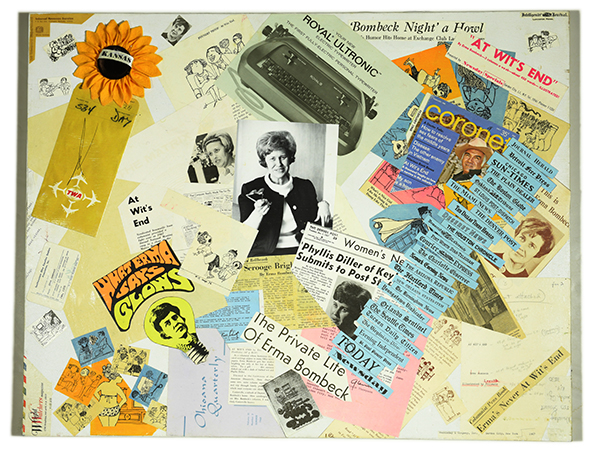
The homemade collage made for Erma Bombeck by her daughter Betsy in the 1970s. - A homemade collage, circa 1970s, by daughter Betsy with a page from the original manuscript of Bombeck’s first book, At Wit’s End, and a photo of her mother superimposed on a lightbulb with the words, “What Erma says glows.”
- Hundreds of photos, most never seen before, from travels around the globe, speaking engagements, book signings and intimate family moments, such as Bombeck sharing a kiss on a street in Spain with husband Bill or laughing with the children around a swimming pool.
- Hundreds of column ideas written on scraps of paper, the back side of column drafts or a legal pad, such as No. 53, Untapped energy — a child’s mouth, or No. 82, Don’t know how I’m going to feel until a bumper sticker comes out.
- A draft of a humorous movie script, never produced, about a son who comes home to live with his parents after living abroad that she co-wrote with son Matt and sold to CBS.
- Letters from readers all over the country who wrote to her as if she were a kindred spirit. “Erma, we are good friends. I know your family. I have been with you during the diaper days, first kid to drive and the sneaker thing; well not really but you know what I mean,” wrote Vincenette Phillips in an Oct. 24, 1990, letter from Arlington, Texas. “Teenagers,” she wrote, “use obscenity like they are getting graded for it. … Words are such a great tool. Do you think the dictionaries in America are locked up? Can you do something about liberating them?”
- An amusing note to Gregory Peck when he was named grand marshal of the Rose Parade: “Since I was Grand Marshal two years ago, there have been flashes in my career, such as introducing the Pope, getting a book on the Best Seller list and flying on an airplane that left on time. However, nothing will ever compare to turning that corner and looking at the sea of happy faces celebrating one of the biggest events of Americana you can imagine. Enjoy it!”
- Typewritten speeches Bombeck delivered while stumping around the country for the passage of the Equal Rights Amendment: “A funny thing happened to me on the way to the utility room. I encountered a revolution. When the first woman stood up one day and said, ‘If God had meant for me to scrub johns, he would have clogged my sinuses,’ I was there. When the first army of homemakers declared, ‘I married my husband for better or for worse … but not for lunch,’ I was on the scene.”
Bombeck enjoyed such immense popularity because she had her finger on the pulse of the 1960s suburban housewife, observed talk show pioneer and longtime friend Phil Donahue, who lived across the street in Centerville, Ohio, early in their careers.
“Motherhood was sacred. Mothers were put on pedestals. Then Erma wrote, ‘I’m going to sell my kids.’ She punctured that pretense and [suddenly] was speaking for millions of women.”
“Motherhood was sacred. Mothers were put on pedestals. Then Erma wrote, ‘I’m going to sell my kids.’ She punctured that pretense and [suddenly] was speaking for millions of women,” said Donahue during a 2014 keynote talk at UD’s Erma Bombeck Writers’ Workshop.
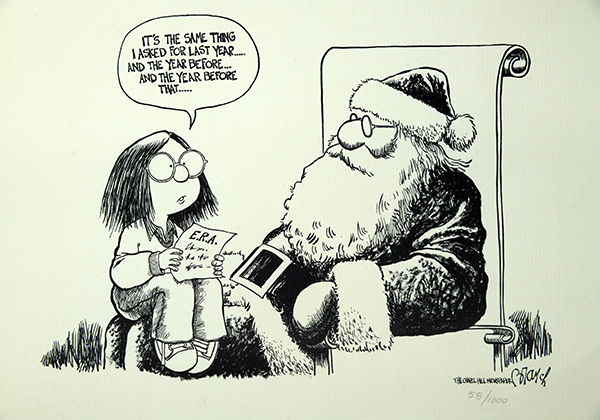
Erma’s papers shine a light on an often-overlooked aspect of the gifted humorist’s life — her vigorous fight for equal rights for women. She served on President Jimmy Carter’s National Advisory Committee for Women and worked tirelessly with sidekick Liz Carpenter, former press secretary to Lady Bird Johnson, for passage of the Equal Rights Amendment, which was never ratified, much to her disappointment.
“I wish that they could put this on my tombstone: She got Missouri for the ERA,” she told a reporter.
Margaret Engel and twin sister Allison would have appreciated the University of Dayton’s treasure trove of original Bombeck material when they were immersed in 180 hours of research, including interviews with the family and leaders of the feminist movement, Ellie Smeal and Gloria Steinem, in preparation for writing their one-woman play, Erma Bombeck: At Wit’s End. It premiered in 2015 at Arena Stage in Washington, D.C., and is still being performed on regional stages around the country, proving the lasting power of Bombeck’s wit and gentle humor.
“Cataloging and digitizing her work is a large and important undertaking and will add so much to illuminating one of the 20th century’s most popular writers,” said Margaret Engel upon hearing news of the collection. “Erma Bombeck’s papers will help the wider world understand her talent, her industriousness and her activism on behalf of women.”
Gina Barreca, a feminist scholar at the University of Connecticut, said Bombeck used humor to expose the stereotypical attitudes of her day that boxed women into traditional roles.
“Bombeck gave women permission to laugh at our own self-imposed boundaries and, by doing so, break through them,” Barreca said. “She was, and remains, the gloriously embraceable heart of the second-wave feminist movement.”
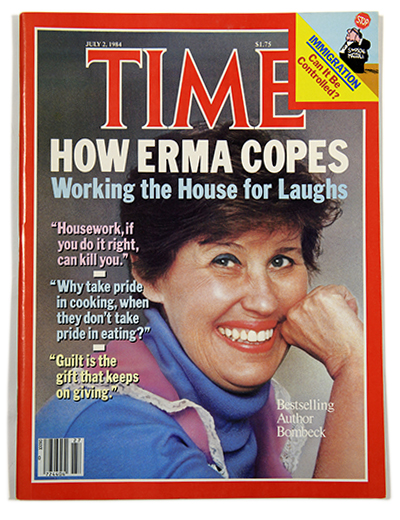
“Bombeck gave women permission to laugh at our own self-imposed boundaries and, by doing so, break through them. She was, and remains, the gloriously embraceable heart of the second-wave feminist movement.”
Perhaps that’s why Bombeck’s writing continues to find an audience. In words tapped out on a typewriter more than half a century ago, Bombeck made everyday life her beat. Through her comical columns and books, she made us look at the absurdities of family life with fresh perspective — and laugh at ourselves. When she exposed the myth of motherhood, her humor was never cruel. She wrote as though we were all in on the joke.
“Her finely tuned columns, carefully constructed so that each reader can, and will, smile, contain not only evocative stories and valuable messages but gem-like phrases and sentences that last in the reader’s memory and serve as touchstones that can be revisited like an old friend,” wrote Lee Salem, editorial director for Universal Press Syndicate, when he nominated Bombeck for a Pulitzer Prize in 1991.
Housed on the campus she loved, Bombeck’s body of work will remain that touchstone — one that can be revisited like an old friend time and again. Her gift of humor transcends time.
The Erma Bombeck Collection is now available for viewing by scholars of popular American humor and feminist studies, as well as the public, by appointment. Email archives@udayton.edu.

